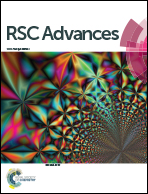Twist fibrous structure of CS–SnO2–PANI ternary hybrid composite for electrochemical capacitance performance
Abstract
In this study, a twisted fibrous CS–SnO2–PANI ternary hybrid composite structure was synthesized via a two step method; the CS–SnO2 hybrid composite was prepared by a simple chemical precipitation method and the resulting CS–SnO2 suspension was coated with PANI by in situ chemical oxidative polymerization of aniline monomer in acidic medium using ammonium persulphate as the oxidant. The resulting respective materials of chitosan, SnO2 and PANI were characterized by using Fourier transform infrared (FTIR) spectroscopy, Raman spectroscopy, X-ray diffraction analysis (XRD) and high resolution scanning electron microscopy (HR-SEM) with energy dispersive X-ray analysis (EDAX), field emission gun-transmission electron microscope (FEG-TEM), thermo-gravimetric (TG) analysis and Brunauer–Emmett–Teller (BET) analysis. The electrochemical capacitors performances were characterized by cyclic voltammetry (CV) and impedance spectroscopy. The electrochemical results demonstrated that the CS–SnO2–PANI ternary hybrid composite achieved 179.20 F g−1 capacitance values in 1 M H2SO4 solution at a 10 mV s−1 potential sweep rate with a maximum of energy density of 8.96 (W h kg−1) and power density of 32.25 (kW kg−1). A synergistic effect among the three components of the chitosan based ternary hybrid composite can be a promising modified electrode material for capacitor applications.


 Please wait while we load your content...
Please wait while we load your content...